
4.5 The Money Market
4 min read•january 2, 2023
Jeanne Stansak
Jeanne Stansak
The Demand For Money
There is an inverse relationship between nominal interest rates and the quantity of money demanded.
This inverse relationship is caused by a couple of reasons:
- People demand a certain amount of money or liquid asset.
If a person chooses to hold $100 in the form of money, he or she is giving up the opportunity to hold $100 of bonds, which would pay a certain nominal interest rate. This nominal interest rate provides some additional purchasing power at the end of the loan period, as well as, compensation for inflation.
- Explanation: The opportunity cost of holding wealth in the form of money instead of in the form of other assets is the nominal interest rate. If interest rates are low, people demand more money because the opportunity cost is lower. If interest rates are high, people demand less money because the opportunity cost is higher.
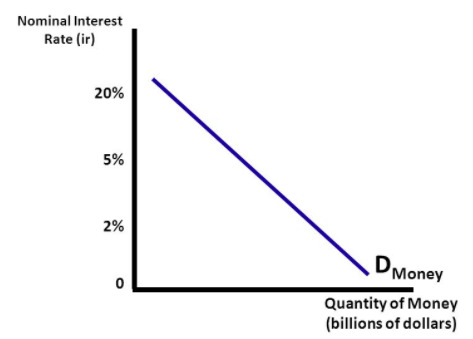
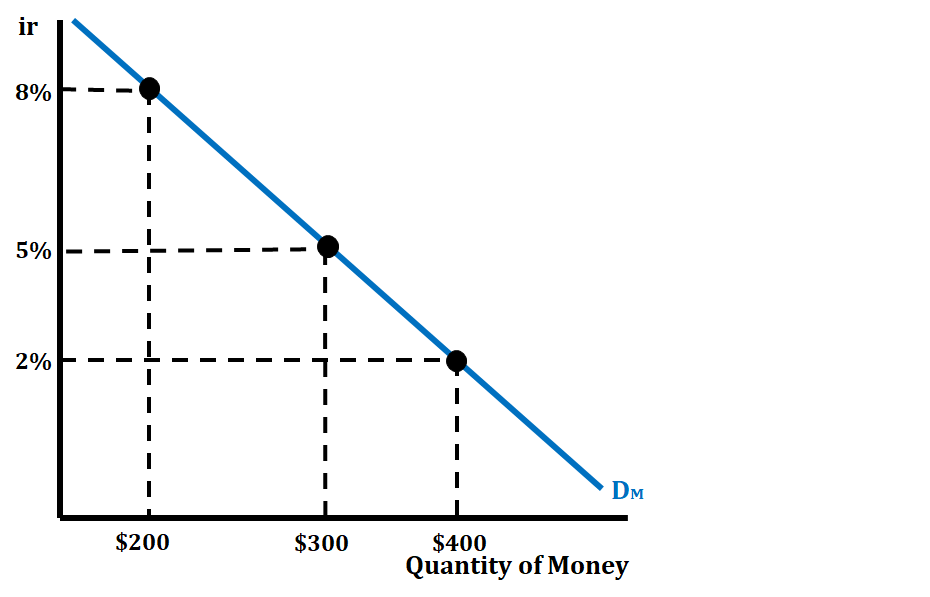
In the graph above, we are able to see the inverse relationship between the nominal interest rate and the quantity of money. As the nominal interest rate drops from 8% to 5%, we see the quantity of money increase from $200 to $300. The opposite is also true. If the nominal interest rate increases from 2% to 8%, we see the quantity of money decrease from $400 to $200.
Shifters of the Demand for Money Curve
Let's look at some examples:
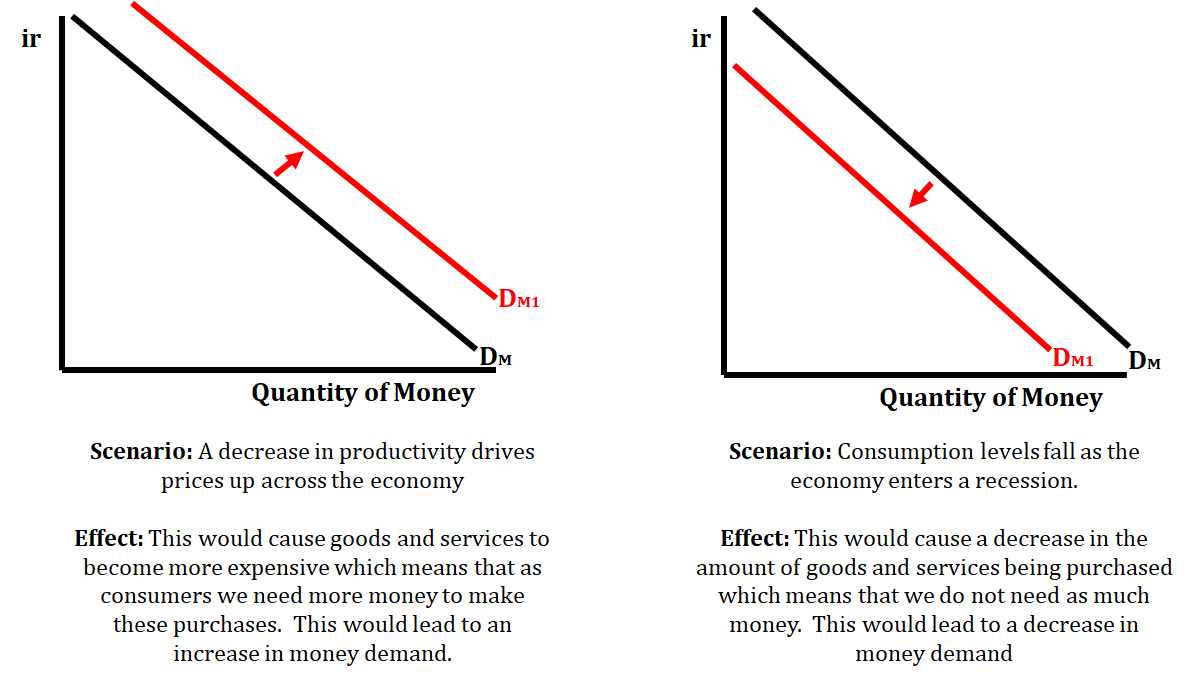
The Supply of Money
The monetary base of a nation is determined by the country’s central bank (FED). This means that the money supply is independent of the nominal interest rate. The supply of money will remain constant regardless of the nominal interest rate. The only way the money supply will change is as a result of monetary policy.
There are three tools that the FED uses to influence the money supply. These include the reserve requirement, the discount rate, open market operations (the buying and selling of bonds), and the federal funds rate.

When the FED uses these tools of monetary policy, they are able to either increase or decrease the money supply. The goal when the FED is using these tools is to either increase or decrease the nominal interest rate, which will cause the economy to expand or contract. We will look at this more closely when we review the money market equilibrium in the next section.

Money Market Equilibrium
Money market equilibrium is achieved when the interest rate at which the quantity of money demanded equals the quantity of money supplied. The nominal interest rate is the interest rate on the vertical axis and the quantity of money is on the horizontal axis.

Remember that the shifters of money demand include a change in the price level, a change in real GDP output, and a change in the transaction costs of spending money. The only shifter of the supply of money is the Federal Reserve.
Let's look at the various ways that the money market equilibrium change through four different examples.
Example 1:
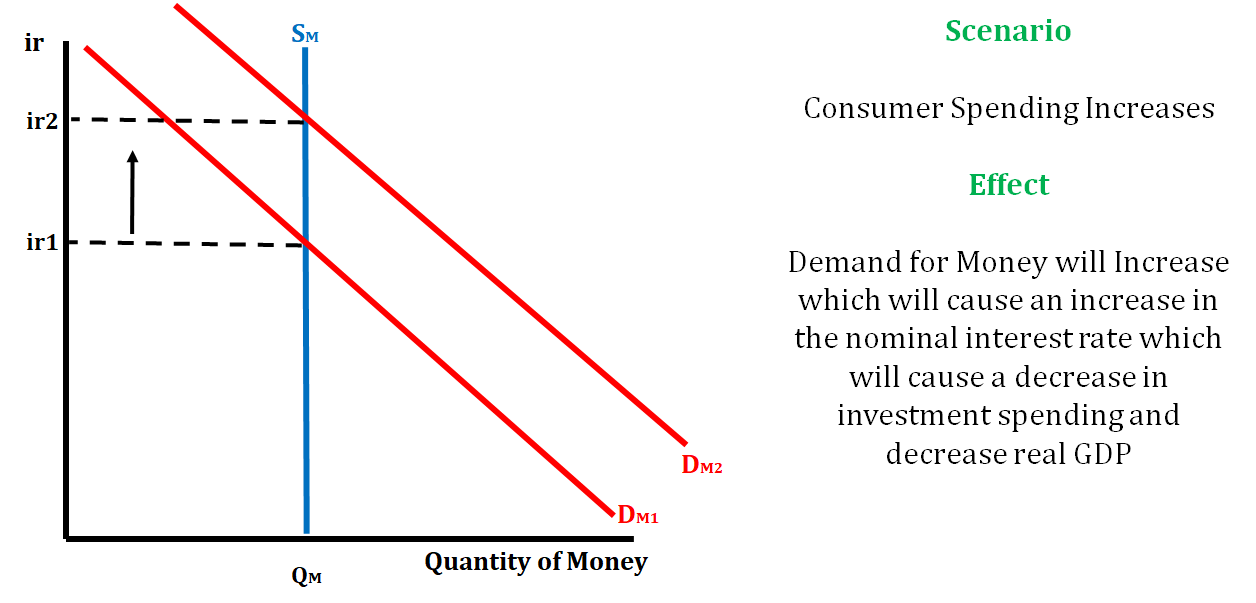
Example 2:
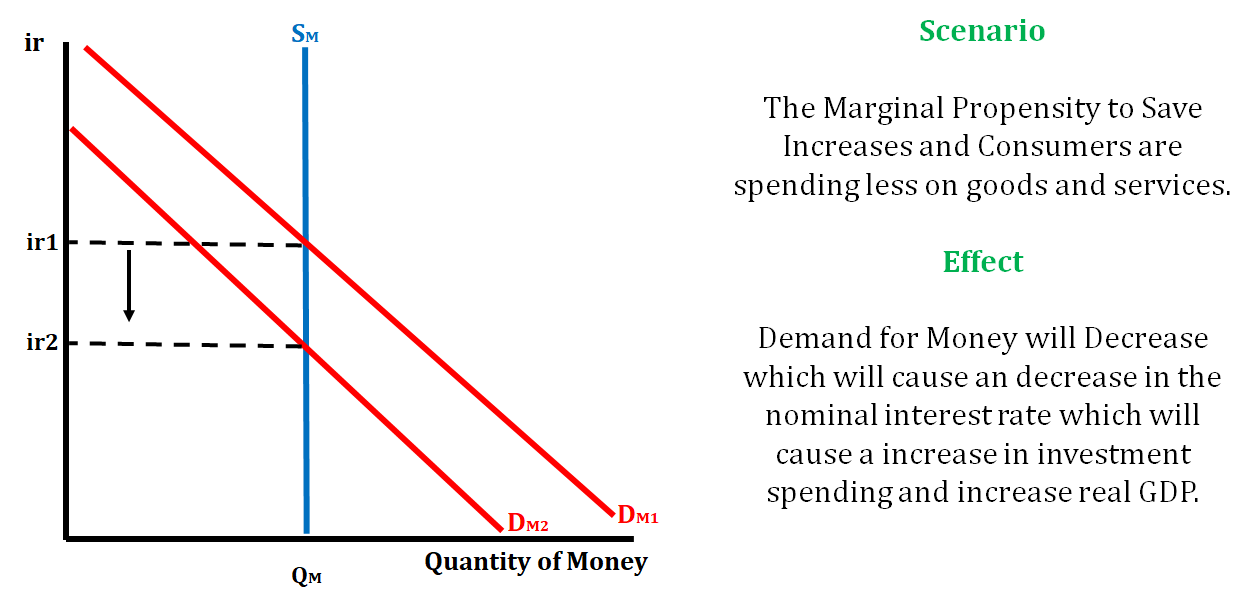
Example 3:

Example 4:
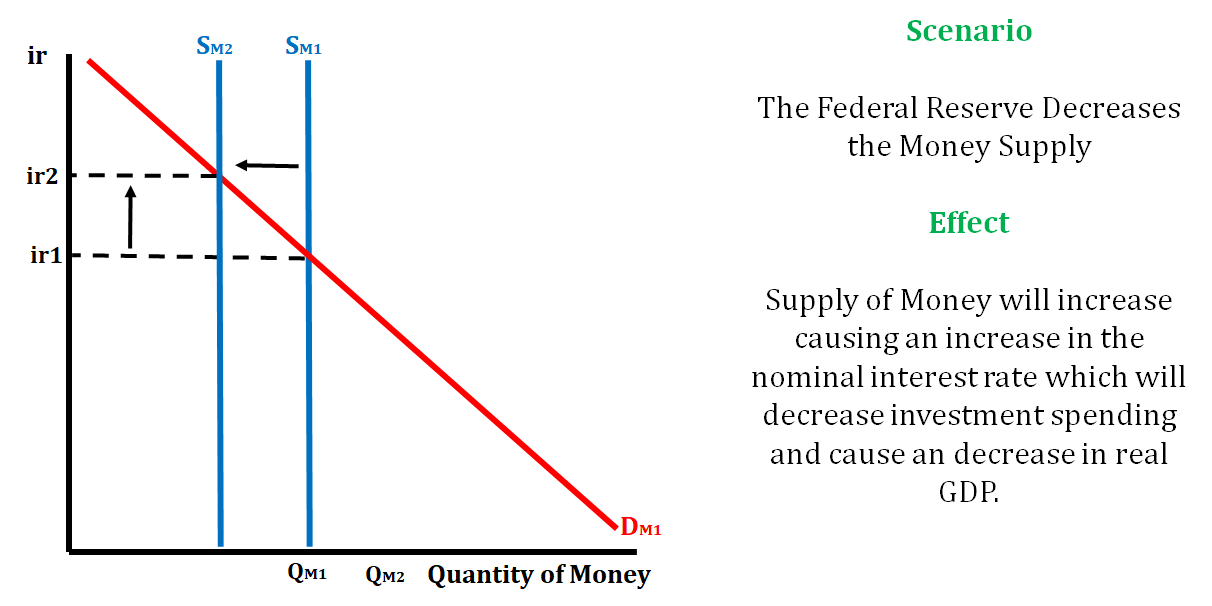
Investment Demand
Investment demand is the desired quantity of investment spending by firms across the economy on physical capital and other resources for the purpose of future productivity/profitability.
There is an inverse relationship between the nominal interest rate and the quantity of investment demanded. When the nominal interest rate falls, we see an increase in the quantity of investment demanded. The opposite is also true. When the nominal interest rate rises, we see a decrease in the quantity of investment demanded.
Investment demand changes due to monetary policy conducted by the Federal Reserve. When they practice an easy monetary policy and increase the money supply, they cause the nominal interest rate to fall, causing the quantity of investment demanded to increase. When they practice a tight monetary policy and decrease the money supply, they cause the nominal interest rate to increase, causing the quantity of investment demanded to decrease.
In the graph below, the Federal Reserve increases the money supply. This action will lower the nominal interest rate, and in turn, cause the quantity of investment demanded to increase.

In the graph below, the Federal Reserve decreases the money supply. This action will raise the nominal interest rate, and in turn, cause the quantity of investment demanded to decrease.
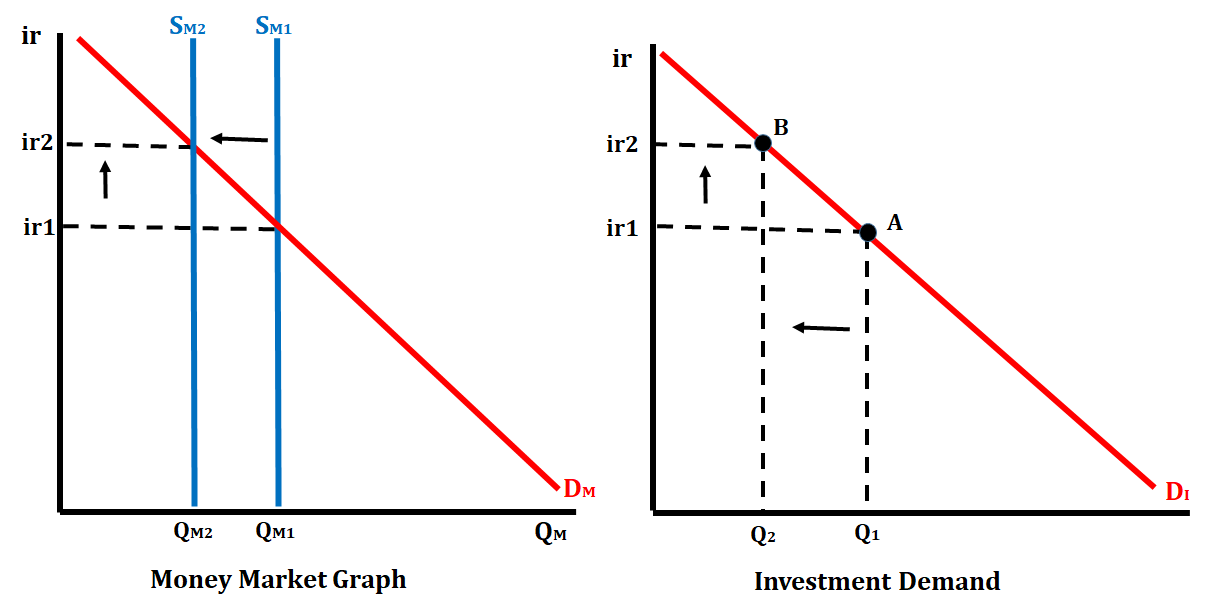
Key Terms to Review (17)
Central Bank
: The central bank is the highest authority in a country's banking system and is responsible for controlling the money supply, regulating banks, and maintaining financial stability.Demand for Money
: The demand for money refers to the desire of individuals and businesses to hold cash or liquid assets for transactions and precautionary purposes.Discount Rate
: The discount rate is the interest rate at which commercial banks can borrow funds directly from the Federal Reserve.Expected inflation rate
: The expected inflation rate refers to the anticipated increase in the general price level of goods and services over a specific period. It is based on predictions made by economists and can impact various economic decisions.Federal funds rate
: The federal funds rate refers to the interest rate at which depository institutions (such as banks) lend and borrow money from each other overnight to meet reserve requirements. It is set by the Federal Reserve and serves as a benchmark for other interest rates in the economy.Investment Demand
: Investment demand refers to the desire of businesses and individuals to invest their money in capital goods such as machinery, equipment, and buildings. It represents the demand side of investment in an economy.Monetary base
: The monetary base refers to the total amount of money in an economy that is held by the central bank. It includes both physical currency (coins and notes) and commercial bank reserves.Monetary Policy
: Monetary policy refers to actions taken by a central bank (such as adjusting interest rates or controlling money supply) to manage and stabilize an economy's money supply, credit availability, and interest rates.Money market equilibrium
: Money market equilibrium refers to the state in which the demand for money equals the supply of money, resulting in a stable interest rate. It occurs when individuals and businesses are willing to hold exactly the amount of money available in the economy.Nominal Interest Rate
: The nominal interest rate refers to the percentage increase in money value that a lender receives from a borrower as compensation for lending money.Open Market Operations
: Open market operations refer to the buying and selling of government securities by the central bank in order to control the money supply and interest rates.Opportunity cost
: Opportunity cost refers to the value of the next best alternative that must be forgone when making a choice between two or more options. It represents what you give up in order to choose something else.Price level
: The price level represents the average level of prices for goods and services in an economy at a given point in time.Real GDP
: Real GDP refers to the total value of all goods and services produced within a country's borders, adjusted for inflation. It measures the economic output of a nation over a specific period.Real Interest Rate
: The real interest rate is the nominal interest rate adjusted for inflation. It represents the purchasing power of borrowed or invested money after accounting for changes in prices over time.Reserve Requirement
: The reserve requirement is the percentage of deposits that banks are required to hold as reserves, which cannot be loaned out. It is set by the central bank to control the amount of money in circulation.Transaction Costs
: Transaction costs refer to the expenses incurred when buying or selling goods, services, or assets. These costs include fees, commissions, and other charges associated with completing a transaction.4.5 The Money Market
4 min read•january 2, 2023
Jeanne Stansak
Jeanne Stansak
The Demand For Money
There is an inverse relationship between nominal interest rates and the quantity of money demanded.
This inverse relationship is caused by a couple of reasons:
- People demand a certain amount of money or liquid asset.
If a person chooses to hold $100 in the form of money, he or she is giving up the opportunity to hold $100 of bonds, which would pay a certain nominal interest rate. This nominal interest rate provides some additional purchasing power at the end of the loan period, as well as, compensation for inflation.
- Explanation: The opportunity cost of holding wealth in the form of money instead of in the form of other assets is the nominal interest rate. If interest rates are low, people demand more money because the opportunity cost is lower. If interest rates are high, people demand less money because the opportunity cost is higher.


In the graph above, we are able to see the inverse relationship between the nominal interest rate and the quantity of money. As the nominal interest rate drops from 8% to 5%, we see the quantity of money increase from $200 to $300. The opposite is also true. If the nominal interest rate increases from 2% to 8%, we see the quantity of money decrease from $400 to $200.
Shifters of the Demand for Money Curve
Let's look at some examples:

The Supply of Money
The monetary base of a nation is determined by the country’s central bank (FED). This means that the money supply is independent of the nominal interest rate. The supply of money will remain constant regardless of the nominal interest rate. The only way the money supply will change is as a result of monetary policy.
There are three tools that the FED uses to influence the money supply. These include the reserve requirement, the discount rate, open market operations (the buying and selling of bonds), and the federal funds rate.

When the FED uses these tools of monetary policy, they are able to either increase or decrease the money supply. The goal when the FED is using these tools is to either increase or decrease the nominal interest rate, which will cause the economy to expand or contract. We will look at this more closely when we review the money market equilibrium in the next section.

Money Market Equilibrium
Money market equilibrium is achieved when the interest rate at which the quantity of money demanded equals the quantity of money supplied. The nominal interest rate is the interest rate on the vertical axis and the quantity of money is on the horizontal axis.

Remember that the shifters of money demand include a change in the price level, a change in real GDP output, and a change in the transaction costs of spending money. The only shifter of the supply of money is the Federal Reserve.
Let's look at the various ways that the money market equilibrium change through four different examples.
Example 1:

Example 2:

Example 3:

Example 4:

Investment Demand
Investment demand is the desired quantity of investment spending by firms across the economy on physical capital and other resources for the purpose of future productivity/profitability.
There is an inverse relationship between the nominal interest rate and the quantity of investment demanded. When the nominal interest rate falls, we see an increase in the quantity of investment demanded. The opposite is also true. When the nominal interest rate rises, we see a decrease in the quantity of investment demanded.
Investment demand changes due to monetary policy conducted by the Federal Reserve. When they practice an easy monetary policy and increase the money supply, they cause the nominal interest rate to fall, causing the quantity of investment demanded to increase. When they practice a tight monetary policy and decrease the money supply, they cause the nominal interest rate to increase, causing the quantity of investment demanded to decrease.
In the graph below, the Federal Reserve increases the money supply. This action will lower the nominal interest rate, and in turn, cause the quantity of investment demanded to increase.

In the graph below, the Federal Reserve decreases the money supply. This action will raise the nominal interest rate, and in turn, cause the quantity of investment demanded to decrease.

Key Terms to Review (17)
Central Bank
: The central bank is the highest authority in a country's banking system and is responsible for controlling the money supply, regulating banks, and maintaining financial stability.Demand for Money
: The demand for money refers to the desire of individuals and businesses to hold cash or liquid assets for transactions and precautionary purposes.Discount Rate
: The discount rate is the interest rate at which commercial banks can borrow funds directly from the Federal Reserve.Expected inflation rate
: The expected inflation rate refers to the anticipated increase in the general price level of goods and services over a specific period. It is based on predictions made by economists and can impact various economic decisions.Federal funds rate
: The federal funds rate refers to the interest rate at which depository institutions (such as banks) lend and borrow money from each other overnight to meet reserve requirements. It is set by the Federal Reserve and serves as a benchmark for other interest rates in the economy.Investment Demand
: Investment demand refers to the desire of businesses and individuals to invest their money in capital goods such as machinery, equipment, and buildings. It represents the demand side of investment in an economy.Monetary base
: The monetary base refers to the total amount of money in an economy that is held by the central bank. It includes both physical currency (coins and notes) and commercial bank reserves.Monetary Policy
: Monetary policy refers to actions taken by a central bank (such as adjusting interest rates or controlling money supply) to manage and stabilize an economy's money supply, credit availability, and interest rates.Money market equilibrium
: Money market equilibrium refers to the state in which the demand for money equals the supply of money, resulting in a stable interest rate. It occurs when individuals and businesses are willing to hold exactly the amount of money available in the economy.Nominal Interest Rate
: The nominal interest rate refers to the percentage increase in money value that a lender receives from a borrower as compensation for lending money.Open Market Operations
: Open market operations refer to the buying and selling of government securities by the central bank in order to control the money supply and interest rates.Opportunity cost
: Opportunity cost refers to the value of the next best alternative that must be forgone when making a choice between two or more options. It represents what you give up in order to choose something else.Price level
: The price level represents the average level of prices for goods and services in an economy at a given point in time.Real GDP
: Real GDP refers to the total value of all goods and services produced within a country's borders, adjusted for inflation. It measures the economic output of a nation over a specific period.Real Interest Rate
: The real interest rate is the nominal interest rate adjusted for inflation. It represents the purchasing power of borrowed or invested money after accounting for changes in prices over time.Reserve Requirement
: The reserve requirement is the percentage of deposits that banks are required to hold as reserves, which cannot be loaned out. It is set by the central bank to control the amount of money in circulation.Transaction Costs
: Transaction costs refer to the expenses incurred when buying or selling goods, services, or assets. These costs include fees, commissions, and other charges associated with completing a transaction.
Resources
© 2024 Fiveable Inc. All rights reserved.
AP® and SAT® are trademarks registered by the College Board, which is not affiliated with, and does not endorse this website.